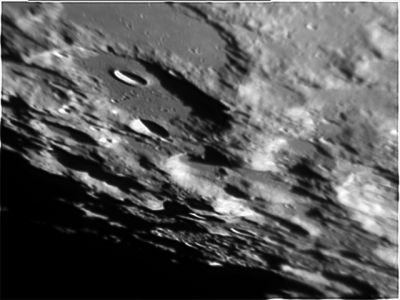Casatus
Contents
Casatus
|
Lat: 72.8°S, Long: 29.5°W, Diam: 108 km, Depth: 5.12 km, Rükl: 72 |

Gustavo Pohls Casatus is the distinctive crater in the upper left, with the smaller craters (Casatus C and J) on its floor and south inner wall.
Images
LPOD Photo Gallery Lunar Orbiter Images Apollo Images
Maps
(LAC zone 137D1) USGS Digital Atlas PDF
Description
Description: Elger
(IAU Directions) CASATUS.--A large walled-plain, about 50 miles in diameter, S.W. of Blancanus, near the limb, remarkable for having one of the loftiest ramparts of all known lunar objects; it rises at one peak on the S.E. to the great height of 22,285 feet above the floor, while there are other peaks nearly as high on the N. and S. The wall is broken on the W. by a fine crater. There is also a crater on the N.E. side of the very depressed floor, together with some craterlets.
Description: Wikipedia
Additional Information
Depth data from Kurt Fisher database
- Westfall, 2000: 5.12 km
- Viscardy, 1985: 3.9 km
- Cherrington, 1969: 3.9 km
Nomenclature
- Named for Paolo Casati (Paulus Casatus) (1617 – December 22, 1707), an Italian Jesuit mathematician. The astronomical work Terra machinis mota (1658) imagines a dialogue between Galileo, Paul Guldin, and Marin Mersenne on various intellectual problems of cosmology, geography, astronomy and geodesy. For example, they discuss how to determine the Earth's dimensions, floating bodies, the phenomena of capillarity, and also describe the experiment on the vacuum made by Otto von Guericke in 1654. The work is remarkable for the fact that it represents Galileo in a positive light, in a Jesuit work, only 25 years after Galileo's condemnation by the Church.
- The name Casatus was introduced on Riccioli's map. Whitaker (p. 211) believes the name was intended for the present feature, although according to a report in IAU Transactions XIIB, Johann Schröter identified it with the crater now known as Drygalski.
- Mary Blagg, in her Collated List, found the present feature (Catalog Number 3289) called Casatus by all three of her authorities, and the that name was adopted in the original IAU nomenclature of Named Lunar Formations.
LPOD Articles
Mountains Near the South Pole.
On Top of the World
Bibliography